When it comes to hot dogs, there are many ways to enjoy them. You can grill them, boil them, or even microwave them.
But what do you do when you have leftover hot dogs that need to be reheated?
In this article, I will guide you through the different methods of reheating hot dogs, as well as offer tips on how to enhance their flavor and deal with common issues.

To begin, it’s important to understand the basics of reheating hot dogs. While it may be tempting to simply toss them in the microwave, this can result in a dry, rubbery texture.
Instead, you want to use a method that will heat the hot dogs evenly and retain their moisture. There are several methods to choose from, including boiling, steaming, grilling, and baking.
Each method has its own advantages and disadvantages, so it’s important to choose the one that works best for you.
Once you have reheated your hot dogs, there are several ways to enhance their flavor. You can add toppings such as ketchup, mustard, relish, or sauerkraut, or experiment with different seasonings.
Additionally, you may encounter common issues such as split hot dogs or unevenly heated hot dogs.
Don’t worry – I will provide tips on how to deal with these issues and ensure that your hot dogs come out perfectly every time.
Key Takeaways
- There are several methods to choose from when reheating hot dogs, including boiling, steaming, grilling, and baking.
- Enhance the flavor of your hot dogs by adding toppings or experimenting with different seasonings.
- Common issues such as split hot dogs or uneven heating can be easily resolved with the right techniques.
Understanding Hot Dogs
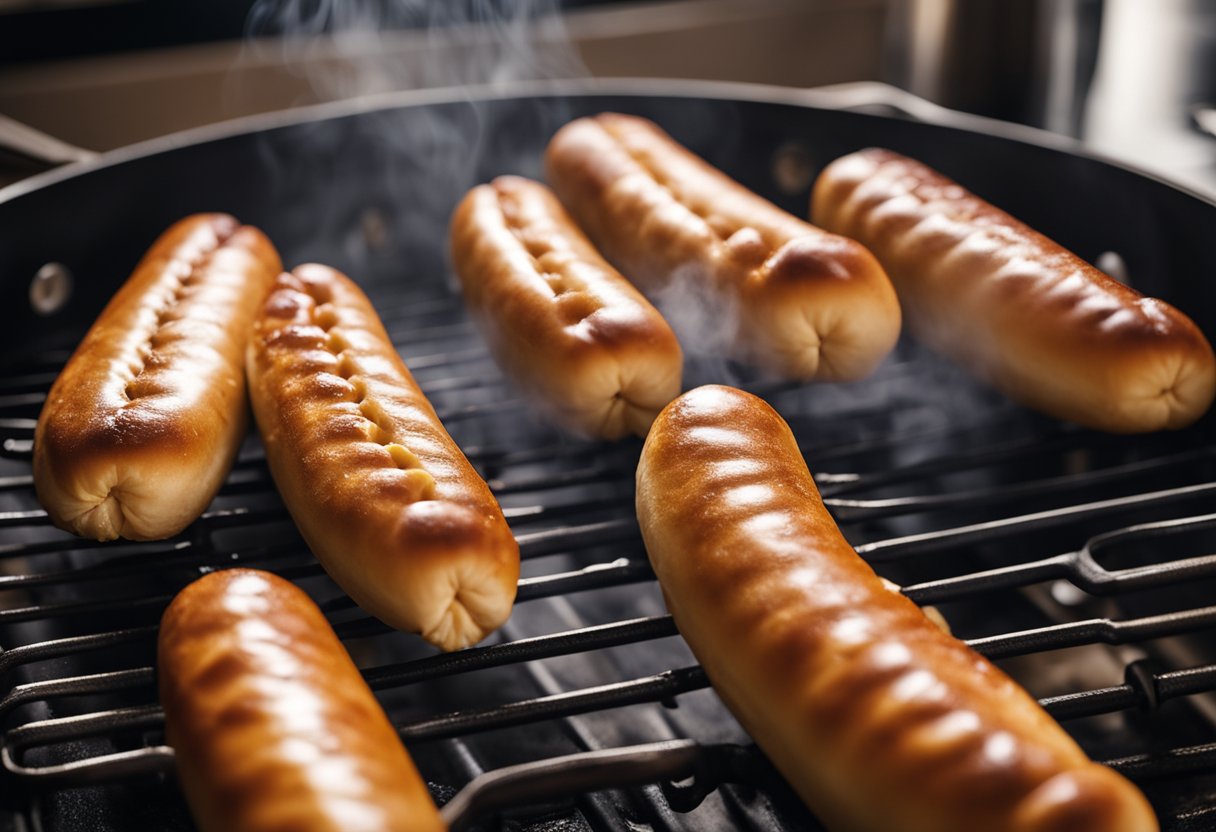
As someone who loves hot dogs, I have learned a lot about them over the years. Here are some basic things you should know about hot dogs before we dive into how to heat them up.
Sausages
Hot dogs are a type of sausage, made from a mixture of meat and spices.
The meat used in hot dogs can vary, but it is typically made from beef, pork, or a combination of the two. Some hot dogs may also contain chicken or turkey.
Casings
Traditionally, hot dogs were made with natural casings, which are made from the intestines of sheep or pigs. However, many modern hot dogs use synthetic casings made from collagen or cellulose.
USDA
The USDA (United States Department of Agriculture) sets standards for the production and labeling of hot dogs.
For example, hot dogs must contain at least 10% meat, and the labeling must accurately reflect the ingredients used.
When it comes to heating up hot dogs, it’s important to keep these basic facts in mind.
By understanding the ingredients and production standards, you can make informed choices about how to cook and enjoy your hot dogs.
Reheating Basics
When reheating hot dogs, it is important to keep safety guidelines in mind to avoid any health risks. Here are some key points to remember:
Safety Guidelines
- Always use clean utensils and cookware when reheating hot dogs to prevent cross-contamination and the spread of bacteria.
- Make sure the hot dogs are fully cooked before reheating them to ensure that any bacteria present is killed off.
- Do not leave hot dogs at room temperature for more than two hours to prevent the growth of harmful bacteria.
Checking the Internal Temperature
To ensure that hot dogs are fully reheated and safe to eat, it is important to check their internal temperature. Here are some tips:
- Use a thermometer to check the internal temperature of the hot dogs. The safe temperature for reheated hot dogs is 165°F.
- Check the temperature in the thickest part of the hot dog to ensure that it is evenly reheated.
- If you do not have a thermometer, you can check that the hot dogs are steaming hot all the way through, with no cold spots.
By following these safety guidelines and checking the internal temperature of reheated hot dogs, you can ensure that they are safe to eat and delicious to enjoy.
Reheating Hot Dogs Using Different Methods
When it comes to reheating hot dogs, there are several methods you can use. In this section, I will discuss the different ways to reheat hot dogs, including using a microwave, oven, stove, air fryer, and grill.
Using a Microwave
The microwave is a quick and easy way to reheat hot dogs. To do this, wrap the hot dogs in a damp paper towel and place them on a microwave-safe plate.
Microwave for 30 seconds, then check for doneness. If needed, microwave for an additional 10-15 seconds until the center is hot.
Using an Oven
The oven is an excellent choice when aiming for evenly heated hot dogs with minimal effort. Preheat your oven to 350°F (175°C).
Place the desired number of hot dogs on a baking sheet lined with aluminum foil. Pricking each hot dog a few times with a fork helps prevent them from bursting. Bake for 15-20 minutes or until heated through.
Using a Stove
To reheat hot dogs on the stove, fill a frying pan with enough water to fully submerge your hot dogs. Bring the water to a boil over medium-high heat.
Add the cold hot dogs into the boiling water and let them cook for about 5 minutes or until heated through. Carefully remove the hot dogs from the pot using tongs or a slotted spoon.
Using an Air Fryer
Air frying is a healthier alternative to deep-frying and is also a great way to reheat hot dogs. Preheat your air fryer to 375°F (190°C).
Place the hot dogs in the air fryer basket and cook for 3-4 minutes or until heated through.
Using a Grill
Grilling is a great way to add a smoky flavor to your reheated hot dogs. Preheat your grill to medium-high heat.
Brush the hot dogs with a little oil and place them on the grill. Cook for 2-3 minutes on each side or until heated through.
No matter which method you choose, make sure to cook hot dogs until they are heated through.
Refrying hot dogs is not recommended as it can cause them to become tough and dry. By using the right technique, you can achieve even reheating and enjoy delicious hot dogs every time.
Enhancing the Flavor
When it comes to hot dogs, there are a variety of ways to enhance their flavor. Here are some tips to make your hot dogs taste even better:
Butter
Buttering your hot dog buns is a simple way to add flavor and richness to your hot dogs. Simply melt some butter in a pan or microwave and brush it onto the buns before toasting them.
Toppings
Toppings are a great way to add flavor and texture to your hot dogs. Some popular options include sauerkraut, relish, chopped onions, and chili.
For a more gourmet twist, try topping your hot dog with caramelized onions, roasted peppers, or crispy bacon.
Condiments
Condiments are an essential part of any hot dog. Some classic options include ketchup, mustard, and mayonnaise. For a more unique flavor, try adding sriracha, BBQ sauce, or honey mustard.
Onion Rings
If you’re looking for a crunchy and flavorful topping for your hot dog, try adding some onion rings. Simply fry up some breaded onion rings and place them on top of your hot dog for a delicious crunch.
Dipping Sauce
If you’re not a fan of traditional condiments, try serving your hot dog with a dipping sauce. Some great options include ranch dressing, honey mustard, or chipotle mayo.
Chicago-Style Hot Dog
For a truly unique and flavorful hot dog experience, try making a Chicago-style hot dog.
This delicious hot dog is topped with yellow mustard, chopped onions, sweet pickle relish, a dill pickle spear, tomato slices, sport peppers, and a dash of celery salt. It’s a flavor explosion in every bite!
Dealing with Common Issues
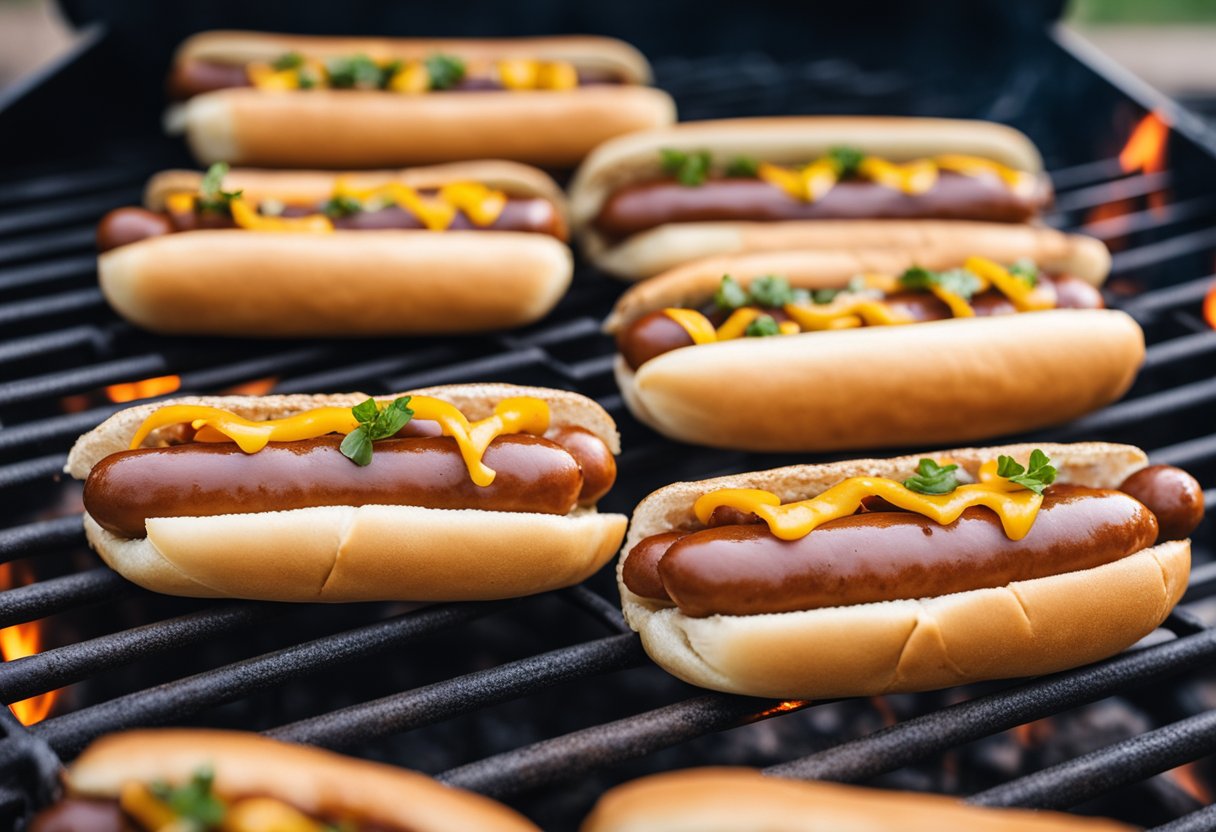
When reheating hot dogs, there are a few common issues that may arise. Here are some tips on how to deal with them.
Burned or Overcooked Hot Dogs
If your hot dogs are burned or overcooked, it may be because they were left in the oven or on the stove for too long.
To prevent this from happening, make sure to set a timer and check the hot dogs frequently to ensure they are not getting too brown.
If the hot dogs are already burned or overcooked, you can try cutting off the burnt ends and serving the rest.
Spongy Hot Dogs
If your hot dogs come out spongy, it may be because they were overcooked or cooked at too low of a temperature.
To prevent this, make sure to cook the hot dogs at the recommended temperature and for the recommended amount of time.
If the hot dogs are already spongy, try cooking them again at a higher temperature for a shorter amount of time.
Crispy Exterior
If your hot dogs come out with a crispy exterior, it may be because they were cooked at too high of a temperature or for too long.
To prevent this, make sure to cook the hot dogs at the recommended temperature and for the recommended amount of time.
If the hot dogs are already crispy, try cooking them again at a lower temperature for a shorter amount of time.
Remember, reheating hot dogs is a simple process, but it does require some attention to detail. By following these tips, you can ensure that your hot dogs come out perfectly every time.
Serving Hot Dogs
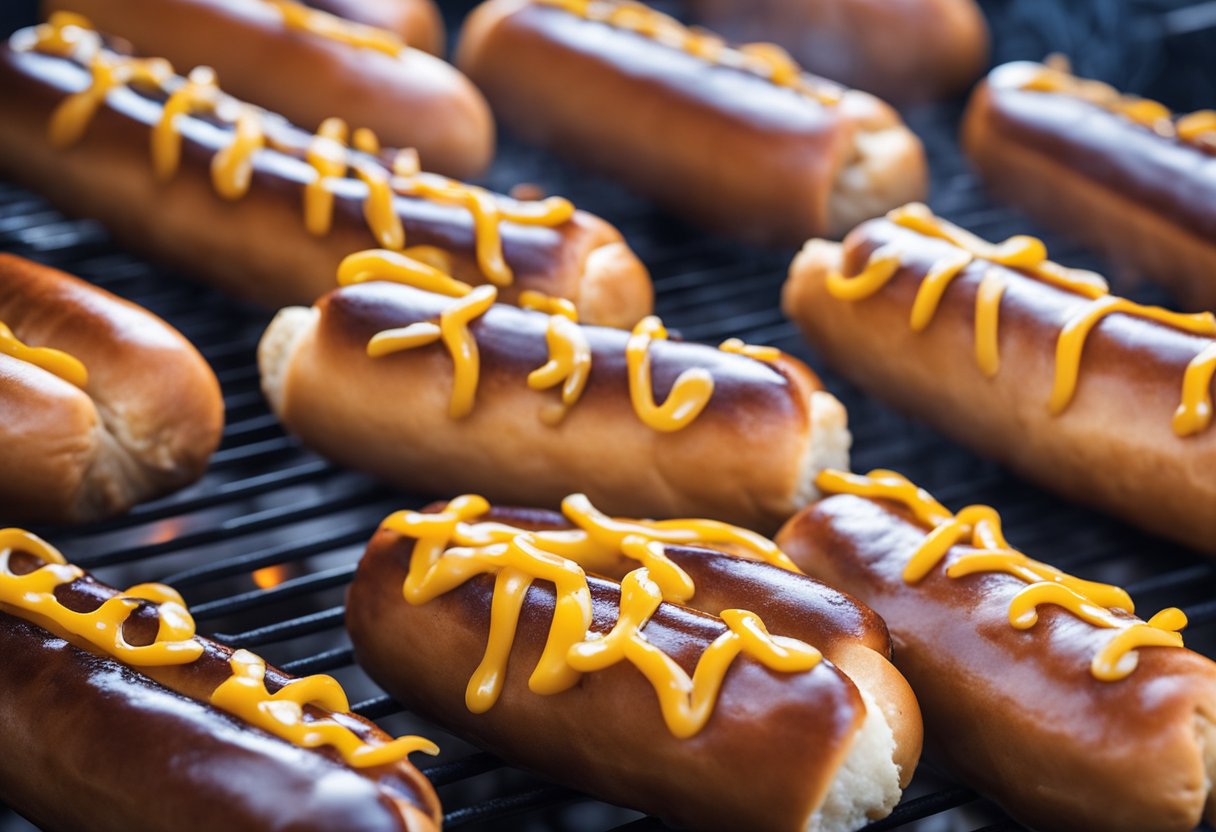
When it comes to serving hot dogs, there are a few things to keep in mind to ensure that they are delicious and safe to eat.
Firstly, it’s important to make sure that your hot dogs are heated through before serving. If you’re using cold hot dogs, you can heat them up by boiling them in water for a few minutes or grilling them over medium heat until they are hot all the way through.
If you’re using pre-cooked hot dogs, you can simply heat them up in the microwave or on the stove.
Once your hot dogs are heated through, it’s time to serve them up! Hot dogs are typically served in a bun, which can be toasted or left as is.
If you’re toasting your bun, you can do so by placing it on a grill or in a toaster oven for a few minutes until it’s lightly browned.
When it comes to toppings, the possibilities are endless! Classic toppings include ketchup, mustard, and relish, but you can also get creative with toppings like chili, cheese, sauerkraut, and onions.
If you’re looking for some hot dog recipe inspiration, check out The Kitchen Table by White for some delicious ideas.
Finally, don’t forget about side dishes! Hot dogs are often served with classic sides like potato chips and coleslaw, but you can also get creative with sides like grilled vegetables, macaroni salad, and chicken breast.
Just make sure to choose sides that complement the flavors of your hot dogs.
By keeping these tips in mind, you can serve up delicious and safe hot dogs that are sure to be a hit with your guests.
Storing and Reheating Leftovers
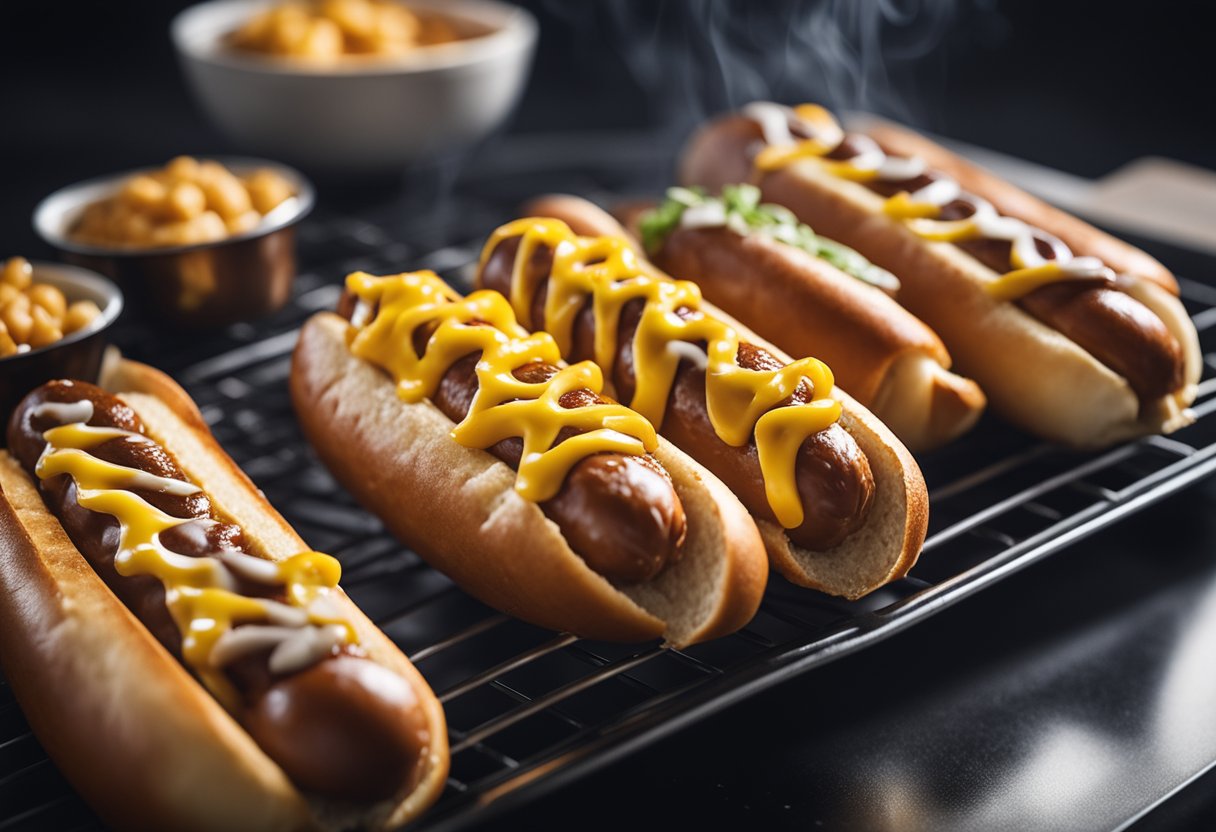
When it comes to hot dogs, it’s not uncommon to have leftovers.
To ensure that your leftover hot dogs are safe to eat and taste just as good as when they were first cooked, it’s important to store them properly and reheat them correctly.
To store leftover hot dogs, place them in an airtight container or wrap them tightly in aluminum foil or plastic wrap.
Then, store them in the refrigerator for up to four days. If you have more hot dogs than you can eat within four days, you can also freeze them for up to two months.
When freezing hot dogs, make sure to wrap them tightly in aluminum foil or plastic wrap and place them in a freezer-safe container or bag.
When it’s time to reheat your leftover hot dogs, there are several methods you can use. One option is to reheat them in a frying pan with a little cooking oil over medium heat.
You can also reheat them in the microwave by placing them on a microwave-safe plate and heating them for 30 seconds on high.
Another option is to use a slow cooker. Simply place the hot dogs in the slow cooker and add enough water to cover them.
Cook on low for 2-3 hours or until the hot dogs are heated through. Using a slow cooker is a great option if you have a lot of hot dogs to reheat and want to keep them warm for an extended period of time.
No matter which method you choose, it’s important to use a meat thermometer to ensure that the hot dogs are heated to an internal temperature of 165°F (74°C) before eating.
This will help ensure that any harmful bacteria present in the hot dogs are destroyed and that they are safe to eat.
Overall, storing and reheating leftover hot dogs is a simple process that can help you avoid food waste and save time in the kitchen.
By following these tips, you can ensure that your leftover hot dogs are safe to eat and taste just as good as when they were first cooked.
Frequently Asked Questions
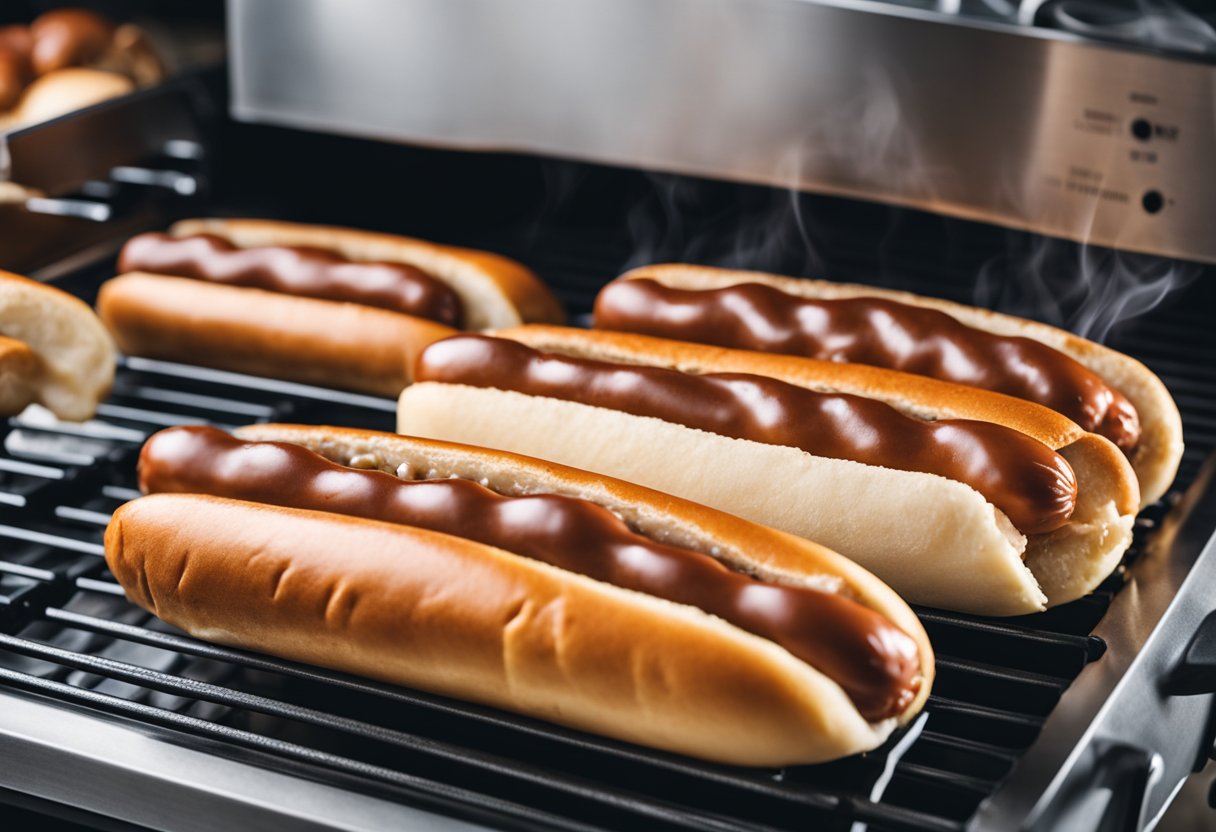
What is the best way to cook hot dogs on a stove without water?
The best way to cook hot dogs on a stove without water is to place them in a skillet or griddle over medium-high heat.
Cook the hot dogs for about 6-8 minutes, turning them occasionally until they are browned on all sides.
How can I cook Nathan’s hot dogs on a stove?
To cook Nathan’s hot dogs on a stove, follow the same instructions as cooking regular hot dogs. Place them in a skillet or griddle over medium-high heat and cook for about 6-8 minutes, turning them occasionally until they are browned on all sides.
How long should I grill hot dogs for?
Grilling hot dogs can take anywhere from 5-10 minutes depending on the heat of the grill and the thickness of the hot dogs. It’s important to turn them frequently to ensure that they are cooked evenly on all sides.
What is the best way to cook hot dogs inside?
The best way to cook hot dogs inside is to broil or bake them in the oven. To broil, place the hot dogs on a baking sheet and broil for about 5-7 minutes, turning them occasionally until they are browned on all sides.
To bake, preheat the oven to 400°F, place the hot dogs on a baking sheet, and bake for about 10-15 minutes, turning them occasionally until they are browned and cooked through.
How long should I broil hot dogs in the oven?
To broil hot dogs in the oven, place them on a baking sheet and broil for about 5-7 minutes, turning them occasionally until they are browned on all sides.
Is it better to boil or microwave hot dogs?
Boiling hot dogs is a quick and easy way to cook them, but it can result in a loss of flavor and texture.
Microwaving hot dogs is a convenient option, but it can also result in a rubbery texture. Grilling or broiling hot dogs is the best way to cook them for optimal flavor and texture.







